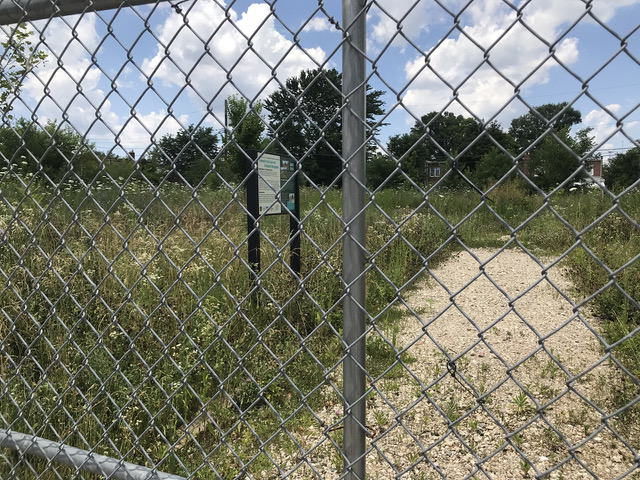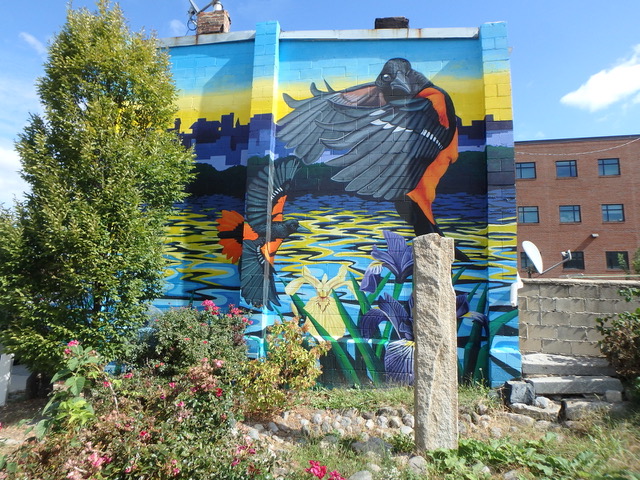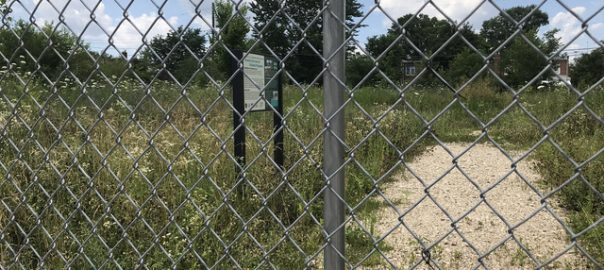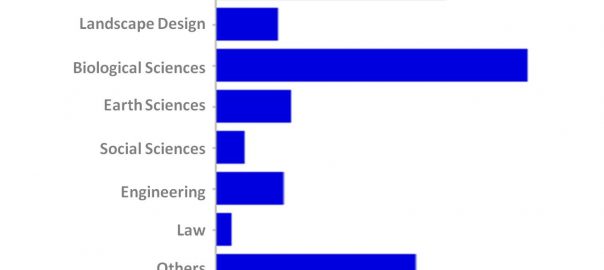White Elephant: 2. figurative. A burdensome or costly objective, enterprise, or possession, esp. one that appears magnificent; a financial liability.
With reference to the story that the kings of Siam (now Thailand)
would make a present of a white elephant to courtiers who had displeased them,
in order to ruin the recipient by the cost of its maintenance.[i]
I.
Often when I write or speak about Baltimore, I begin by contextualizing the city as divided. I refer to Dr. Lawrence Brown’s conceptualization of the “White L and the Black Butterfly” to describe the deep racial segregation that has been meticulously crafted for decades.[ii] In other cases, I use a 1.32 mile stretch of abandoned interstate that bisects west Baltimore as an example of the many deliberate steps made by the city and federal government to fracture black neighborhoods.[iii] Indeed, Donald Trump’s 2019 summertime screed riffed on this familiar narrative when he declared the city filthy, rat infested, and dangerous.[iv]
Yet, the lived experience of trauma and civic disregard are a near universal for all of Baltimore’s residents. To live in the city and pretend that its ills are concentrated in specific geographies, cultures, and people, demonstrates a willful choice to disregard the moral obligations of civic participation. This choice also makes the social and material systems of division durable, ensuring that the spatial racism of segregation continues to define the environment.[v] Thus, it seems necessary to work towards a different narrative of a divided Baltimore. This alternative telling will refuse to naturalize deliberate practices of exclusion and racism as a matter of fact, and instead considers the perpetuation of these systems as matters of maintenance—that is, they are actively maintained by governance practices.[vi]
II.
When I arrived in Baltimore two years ago as a postdoctoral researcher assigned to study residential perceptions of green infrastructure, I was repeatedly told that the problem with these technologies was a lack of regular maintenance. The story goes something like this: For the past 15 years, the city of Baltimore and a variety of environmentally focused non-profit organizations have built landscaped facilities, such as bio-swales or raingardens, to counter the environmental impacts of urban stormwater runoff.
When it rains, water flows over impervious surfaces before reaching a storm sewer. In a separated sewer system like Baltimore’s where runoff remains separate from household wastewater and effluent, the discharge flows directly into receiving water bodies. Impervious surfaces, such as roads, sidewalks, and buildings, house a number of nutrients—nitrogen and phosphorus- as well as other chemicals, oils, and microscopic refuse. When it rains, those pollutants travel into the storm sewer where these particles eventually find a home, past the outfall pipes to our lakes, rivers, and bays.

Green stormwater infrastructure slows or stops the quick conveyance of nutrients during rain events and helps to achieve larger environmental regulatory goals. To this day, Maryland stands at forefront of enacting strong, statewide, environmental regulations. Popularly, this history traces back to the state’s reliance on the Chesapeake Bay for both commerce and recreation. The state was an original signatory of the landmark 1987 Chesapeake Bay Agreement, which set actionable benchmarks to restore the ecological function of the watershed.[vii]
Maryland’s first regulations addressing stormwater quality came in the mid 1980s. This led to the widespread adoption of stormwater ponds, broadly referred to as “best management practices” or BMP’s. These installations might be considered the first generation of green infrastructure. Generally, a grass swale or pond would be built to retain or detain stormwater. Facilities were often quite large but required minimal maintenance through mowing and clearing of drains.[viii]
Subsequent regulations moved away from the large-scale management practices and instead mandated environmental site design, or smaller, discrete installations that mimic the natural, pre-development characteristics of a site. Environmental site design came with new maintenance burdens including plant and filter media replacement, cleaning of inlets, and regular trash removal.
If one constant persistently emerges in the history of stormwater infrastructure, as John William Knapp dryly put it in his 1965 report “Economic Study of Urban and Highway Drainage Systems”, it is that storm sewers are not “self-liquidating”. Knapp, ever the engineer, used this phrase to signify that storm sewers will never produce value or provide any direct return on investment.[ix] Indeed, the outcry in Maryland around the passage of a “stormwater management fee”, publicly rebranded the “rain tax”, demonstrates the durability of Knapp’s words. Not only is the value of stormwater management only vaguely perceptible or indirectly valuable, paying for the function provokes widespread public outrage.[x]
So, on one side, we might isolate the problem of green infrastructure in a general trend of neglect, disinvestment, or at the very, least minimal investment, associated with the long-term maintenance of the storm sewer system. On the other side, the State of Maryland requires all municipalities to comply with environmental regulations to improve water quality through the mitigation of nonpoint source runoff. The admixture of these two factors means that environmental solutions to urban stormwater runoff are both mandatory and financially challenged from the start.
III.
Complicating matters further in the city of Baltimore is that a number of non-profit organizations regularly construct and implement green infrastructure in collaboration with community groups, churches, or neighborhood associations. These projects are often done with the overall well-meaning impulse and justification of restoring environmental and neighborhood health through community greening.
The multitude of implementers has produced a secondary problem of illegibility. No single agency or institution knows where all of the facilities in the city are located. This is a nightmare for those looking to meet regulatory requirements, as well as those hoping to track the beneficial impacts of a facility within a neighborhood.
While some of Baltimore’s green stormwater infrastructure currently sits in good condition, other sites are functionally abandoned. The reasons given for this bifurcation of technological failure are plentiful. The Department of Public Works struggles to train workers to tend to the plantings.[xi] Non-profit organizations who build facilities rely on community maintenance agreements that lack binding enforcement mechanisms.[xii] Residents complain to 311 (the government’s complaint line) that facilities are unkempt and suddenly a site is mowed down overnight.[xiii]
Despite the multitude of breakdowns, engineers, project managers, landscape architects, and city planners all remark that once the problems of maintenance are solved, the number of facilities will expand, providing residents with a variety of loosely defined ecosystem services. The technology is inevitable, or at the very least desirable. Some stakeholders express that more robust and resilient social systems are needed. These systems might look like incentives or disincentives to encourage regular upkeep, or they might take the form of work force development geared at training workers for the green jobs economy.
I’ve come to understand through my conversations and interviews with residents, city officials, and other stakeholders that the problem of facility maintenance serves as a red herring. A lack of maintenance, the trash littered swales, and the browning vegetation signal a more devastating absence. Focusing so narrowly on technological function has neglected the system, or more appropriately, systems, at work within urban space.
The failure to care for facilities and make them persist into the future is in itself a form of systemic maintenance that perpetuates environmental segregation into the future. By failing to develop a system to adequately keep track of, monitor, and maintain green infrastructure as a public asset, the green visionaries of years past demonstrated that project completion mattered more than future durability. In the process of trying to create a more sustainable city, institutional stakeholders effectively created an unsustainable system.
My critique should be countered with the recognition that structural hurdles stand in the way of planning for maintenance. For instance, The Chesapeake Bay Trust, who gives money for green infrastructure projects does not provide funding for maintenance because they cannot commit project “funding in perpetuity”.[xiv] Still, millions of dollars from the state and federal government have been paid out to support these projects with the promise that residents and community groups will take care of facility maintenance.[xv]
I need to highlight the absurdity of this logic for a moment. The obligation to maintain some public assets falls not on hired work crews or trained professionals, but on residents who supposedly have the time to pick up trash, remove weeds, and clear sediment. What makes this irony even more perverse is the near constant mention of “planning for equity” in relation to green infrastructure projects. How can city greening be equitable when the ability to devote time and bodily labor is itself a marker of relative privilege and physical capacity?
Recognizing this, I became interested in how residents understand their civic obligation to care for and maintain urban space when the state has a history of neglect and private capital steps back once the ribbon cutting concludes. Specifically, how do residents describe their experience of providing maintenance to public spaces and facilities in the face of these obstacles?
IV.
During process of interviewing residents about their perceptions of green infrastructure, I learned about their relationship to the urban environment in Baltimore. Those I interviewed for this project have predominantly been women, many of whom profess to possessing a strong “environmental ethic”. In addition to these similarities many, although not all, participants live in neighborhoods in the upper categories of the City’s housing market typology.[xvi] These neighborhoods are generally well established, relatively affluent, and have fewer vacant properties. I draw attention to this to mark that the experiences I am about to discuss are not representative of the city at-large, but do point to the emergence of shared challenges that residents face when implementing green infrastructure projects.
A small neighborhood in East Baltimore occupies three squared city blocks. Within these blocks are three rain gardens. Each facility is primarily maintained by Dana (all names in this essay are changed), a long-time neighborhood resident. When she talks about her experience with the rain gardens she emphasizes how proud she is of her work and how she feels that the gardens are “an advantage to the neighborhood”.[xvii] For Dana, her investment in the maintenance and care of the rain gardens is an extension of what she calls her “personal ethos”. She told me, “I believe… that it’s my responsibility to make the city the best that it can be, it’s my responsibility to make our neighborhood the best that it can be.”
Still, she harbors frustration about the lack of support she receives from the city to continue the upkeep. To keep a rain garden functional, plants need to be replaced, trash disposed of, blockages cleared, and weeds removed. All of these activities produce yard waste. Dana has called the city to try and arrange a bulk trash pick-up to no avail. Instead, she carts the waste in a wheelbarrow to her house and hopes she doesn’t exceed her weekly allotment for trash pick-up.
In other interviews, respondents tended to view the work of the environmental non-profits as generally positive, with a few reservations. Some described how organizations became very hands off once a project was over, making communication about continuing maintenance challenging. Still, in face of these challenges, respondents placed blame on the city, rather than the implementing organization, for failing to adequately respond to instances of curb breakage or filter-material failure.
Others mentioned the “whiteness” of environmental nonprofits and a broader failure, I quote, “to engage people of color, despite their best and most sincere efforts.” Additionally, it is difficult for community members to obtain information for why a project might be canceled or failed to materialize. At least two people mentioned a citywide project to repave alleyways with permeable surfaces. Despite community interest, the project never got off the ground, leading residents to speculate as to the reasons for the cancellation.
These multiple perspectives from respondents describe how the institutions operating in Baltimore have failed to consider the systems needed to keep green infrastructure functional. The problem is not as simple as an organization coming into a neighborhood, building a facility, and leaving the community to continue its upkeep. Instead, once built, green infrastructure occupies a public space and intersects with other urban systems and struggles including trash pick-up, community and individual capacity, and ill-defined institutional roles. Figuring out how to bring these systems, experiences, and institutions in line with one another needs to be discussed at the genesis of green infrastructure projects; not haphazardly arranged once the project is already in the ground, enthusiasm has waned, and the project leaders have moved on.
V.
While the responses above generally emerge from respondents who live in upper categories of the housing market typology, Jenna, a community leader, resides in a neighborhood firmly in the middle of this classification. Over the course of our conversation, she described her involvement in her community as catalyzed by neighborhood change. When Baltimore City closed the recreation center, long-time residents sold their homes, and many properties transitioned into rentals or low income units. The change provoked by this shift led to Jenna’s increasing engagement in the neighborhood—she regularly organizes with community members to pick up trash, clear clogged storm drains, and mentor young residents.
At the conclusion of my interviews, I ask all respondents to describe how they care for and maintain their community, and whether they feel they have a responsibility to engage in these efforts. Jenna’s answer began with a story:
Every August we repaint our crosswalks, so that kids can safely go back to school. We do this because we care about the children, we care about our community looking nice, and honestly, we have a good time. We buy tarmac paint, we have a couple glasses of wine, and we get out there with giant paint rollers. We paint crosswalks because we care about the community.
She then continued on to say:
If we rephrased that and say; “This is a maintenance job that was requested five years ago, it should be paid for by our tax dollars and it should be handled by someone on city payroll,” I think that we would begin to see the balance shift between neighbors coming together to care for their community and individuals feeling as if they are being burdened with the responsibility to maintain their community. I think that we have been very intentionally making our actions come from a position of compassion and caring even though the actual actions that we do in many instances are those of maintaining a community.
I quote Jenna at length to capture a tension worth dwelling on. Providing maintenance to a neighborhood or a public space signals an absence or larger pattern of neglect. Maintenance evokes a quantifiable and necessary labor to keep a given space functional as designed. Caring, as an act of compassion, as a civic virtue, captures an action both personally satisfying and collectively fulfilling. To care does not require the perpetuation of a specific function, nor does it seek to sustain the environment as it is currently arranged. Care in this configuration acts as a radical intervention that produces changes outside of technological, administrative, or governmental legibility.
The divide Jenna signals between care and maintenance was not shared by all participants. Another woman, when asked about the relationship between maintenance and care, saw the two as the same. She used the metaphor of taking care of a baby to illustrate the similarity—you care for a baby, but that care requires repetitive tasks so that the child can remain healthy and happy. She told me, “Maintenance is an expression of caring.
Another, a recent city resident who does not consider herself particularly involved or well versed on local environmental issues, demarcated care as a public activity and maintenance as an activity she conducts in her home. Plant watering in the house was described as activity of maintenance, while the choices she makes through her work in social justice spaces comes from a place of care.
The wide variation of personal definitions and understandings of “care” and “maintenance” cut to the core of what I believe to be a significant, if not the most significant issue related to green infrastructure adoption, acceptance, and perpetuation in Baltimore City. Practices of care have been co-opted into public maintenance regimes. By relying on the assumption that residents are able and willing to provide care to the local environment, the deployment of green infrastructure has neglected to develop system-spanning governance practices to support facilities into the future.
Thus, when I suggested earlier to conceptualize the problem of green infrastructure as a matter of maintenance, I aimed to move beyond the focus on cultivating individual efforts or obligations. Instead, green infrastructure needs to be designed to rely less on the individual ability of community members and more on the supportive capacity of existing institutions within those spaces. Let community members continue to care, to provide care, and choose where that care is placed. Resist the temptation to rely on such care as the primary source of functional maintenance.

VI.
What has surprised me most in conducting interviews is how strongly some residents describe a moral obligation to care for their neighborhoods, and the ways that maintaining green infrastructure allows them to act as stewards of urban space. Despite the systemic entanglements, and occasional failures, many describe a feeling as if they are working towards achieving a common good. But, cities cannot rely on the labor and passion of a few as justification for a system that affects many.
The failure to plan for the contingencies of green infrastructure presents a small, but meaningful example of how divisions are maintained. Institutional actors assume green infrastructure will be beneficial for all, without considering the intersecting and uneven challenges residents may face when welcoming a project to their neighborhood.
Often in academic literature, green infrastructure is understood as a universal good that provides a suite of apparent benefits including lessening the effects of urban heat island, reducing crime, producing better mental health outcomes, and achieving pollution reduction.[xviii] As it was recently described in a public meeting, “green infrastructure is the answer to many, many questions”.[xix] In Baltimore, it appears that this universal good comes to mean that residents should care universally.
The deterministic good of green infrastructure quickly falls apart upon examination. The health and social benefits cited by supporters are often far more qualified when traced back to the originating source. For instance, a 2007 review article on health and green infrastructure states that “Green areas in one’s living environment may ameliorate air pollution, and the urban heat island effect”.[xx] This statement points to an article that concludes that indicators of ecological performance improve in proportion to green space and tree cover.[xxi] To put it another way, areas with more tree cover and more green space have a higher ecological function than spaces with less tree cover and less green space.
This observation has practical consequences for planning decisions that can target canopy increase or green space expansion, but the cited article does not explicitly make the case that green areas, let alone green infrastructure, ameliorates environmental harm. Harm is not the absence of a function, it is the product of the intertwined social, ecological, technical, and political systems that perpetuate the function as normal.
Adding green infrastructure to a neighborhood will not magically act as a salve. Indeed, the current logic of green infrastructure construction is deeply intertwined in the continued perpetuation of harm by a refusal to recognize that greening is not always, and in all contexts, a benefit.
To be clear, I am not arguing against urban greening or efforts that promote environmental change. Nor am I calling into question the validity of the sciences that demonstrate ecological function within urban environments. What I am saying is that a troubling logic of technological and environmental determinism underlies the drive for green infrastructure development. This focus universalizes the effects of targeted environmental change with little attention to how shifts within public space are actually experienced individually and collectively.
To overcome the fractures in Baltimore, the first step must be a sustained commitment to evaluate the many systems that maintain segregation of all forms. It must be recognized that green infrastructure cannot stand outside of these forces. But perhaps we can design, implement, and plan these facilities in a way that changes the course of how we choose to maintain the fabric of urban life.
VII.
This essay’s title refers to the idea of a “White Elephant”. Some may be familiar with that term from the popular holiday game where the gift received is left up to chance, and in some cases thievery. The term’s origins are more literal, pronouncing an actual white elephant as a burdensome and financially ruining gift.
To play devil’s advocate momentarily, the white elephant might not be equally burdensome to all. Suppose the recipient owns an elephant sanctuary or otherwise possesses the existing infrastructure to embrace the gift. The recipient would probably need to acquire other elephants just to make sure the animal is happy in his new environment. And, I’m speculating here, but there also might be some need to invest in industrial strength sunblock to protect the delicate skin of the pale creature. From my perspective, this seems like a lot of work. But for someone, the burden of labor, cost, and care, might be perceived as a benefit. Whether the white elephant is burdensome or not depends on the context into which it is placed. The same is true for green infrastructure.
The past era of infrastructural construction led to the perception of systems within the built environment as invisible and functionally homogenous.[xxii] Sewers carried away refuse and electrical lines delivered energy. Yet, in the contemporary era we’ve witnessed a fracturing of infrastructural function, often along clear sociodemographic lines. Lead pipes still remain in Flint, Michigan and Newark, New Jersey and vacancy rates increase in neighborhoods previously redlined. Simply, infrastructure provision and improvement has never been equitable, and in many cases this has actively produced harm.
But, a history of harm does not portend a future of the same. What I have called attention to in this essay are the multiple institutions and individuals who are ostensibly working to better the city, to create a healthier space to live, and to improve the environmental condition of the larger region. These are noble and necessary pursuits and should be treated as such.
Funds need to be dedicated to creating collaborative governing institutions that can address this issue. This suggestion is not even remotely novel. Multi-jurisdictional agencies, such as Maryland’s Regional Planning Council have been at the forefront of developing collaborative environmental remediation projects since the 1970s. What needs to change is who is included and recognition of the capacities of participants involved.
I’m thinking here of Sandra Harding’s concept of “strong objectivity” where voices from below, such as women and marginalized populations, “demand[s] interrogation of just which cultural commitments can advance growth of the kinds of knowledge a particular community desires”.[xxiii] Harding is speaking here specifically about objectivity in scientific research, but there is overlap to technological adoption. For green infrastructure to not be burdensome, projects must begin with community desire, which can be served and made material by trained experts.
This inversion of power in public projects will undoubtedly challenge and change institutional structures. Struggles over meeting regulatory requirements, achieving larger restoration goals, and ensuring that systems are adequately and properly maintained are components of this shift, but not entirely constitutive of the governing effort. By using community desire as a guide, cities can refocus civic relationships to better embrace the capacity that communities possess in bounds, a public ethic of care.
The history of green infrastructure implementation in Baltimore shows that what communities care about and care for has been co-opted into requirements of maintenance that can become burdens for those same communities. The current state of many facilities demonstrates this approach is not effective. It is time to experiment with a new way forward.
Amanda Phillips de Lucas
Baltimore
Notes:
i — “white elephant, n.”. OED Online. September 2019. Oxford University Press. https://www-oed-com.ezproxy.lib.vt.edu/view/Entry/399143?redirectedFrom=White+Elephant (accessed November 05, 2019).
ii — Brown, Lawrence. ‘Two Baltimores: The White L vs. the Black Butterfly.’ 28 June 2016. Baltimore City Paper. https://www.baltimoresun.com/citypaper/bcpnews-two-baltimores-the-white-l-vs-the-black-butterfly-20160628-htmlstory.html
iii — Phillips de Lucas, Amanda. ‘Producing the Highway to Nowhere: Social Understandings of Space in Baltimore 1944-1974.’ [In Review].
iv — @realDonaldTrump. “….As proven last week during a Congressional tour, the Border is clean, efficient & well run, just very crowded. Cumming District is a disgusting, rat and rodent infested mess. If he spent more time in Baltimore, maybe he could help clean up this very dangerous & filthy place.” Twitter, 29 July 2019, 7:14 a.m. https://twitter.com/realDonaldTrump/status/1155073965880172544?s=20
v — My thinking in this essay is indebted to Steward Pickett’s observations that racial segregation is a near universal in the landscape, that segregation is spatialized racism, and that segregation is in itself a system that impacts the environment. These observations suggest that ecologists and environmental scientists need to work to both theorize and study the ‘ecology of segregation’. Pickett’s work, along with substantive contributions from J. Morgan Grove, Billy Hall, Dexter Locke, Laura Ogden and others are beginning to the establish the empirical and historical insights overlooked by this disciplinary omission.
vi — This turn of phrase comes from Bruno Latour’s mea culpa, Why has Critique Run out of Steam? From Matters of Fact to Matters of Concern. To quote Latour, “The mistake I made, was to believe that there was no efficient way to criticize matters of fact except by moving away from them and directing one’s attention toward the conditions that made them possible (231). His intervention here, referencing Donna Haraway, advocates for a form of radical constructivism oriented toward the laudable goal of care. I need to emphasize, that the reference to Latour does not mean that I am advocating for a similar turn. Indeed, this article takes critique as its primary mode of address to reveal how facts are constructed within different modes of professional expertise and personal experience. Turning to the question of what I am calling matters of maintenance begins to address how systems of neglect are made to persist into the future, into different spaces, and laden with diverse meanings.
vii —“The Chesapeake Bay is a national treasure and a resource of worldwide significance. It’s ecological, economic, and cultural importance are felt far beyond its waters and the communities that line its shores. Man’s use and abuse of its bounty, however, together with the continued growth and development of population in its watershed have taken a toll on the bay system.” https://www.chesapeakebay.net/content/publications/cbp_12510.pdf
viii — Interview with Tom Schueler, Center for Watershed Protection, 2018.
ix — “No ready market exists in which to establish the value of these savings, and the beneficiaries, who receive the benefits without voluntary purchase, are only vaguely aware of the values involved”. Knapp, John William. ‘An Economic Study of Urban and Highway Drainage Systems.’ June 1965. Progress Report of the Storm Drainage Project. Johns Hopkins University, Department of Sanitary Engineering and Water Resources. Johns Hopkins Libraries. TD7 .J6 no.1 c.1.
x — Current Governor of Maryland, Larry Hogan, campaigned using the platform of ‘repealing the rain tax’ complete the high political theater of handing out branded umbrellas. https://www.washingtonpost.com/local/md-politics/maryland-lawmakers-defeat-hogan-proposal-to-eliminate-rain-tax/2015/03/06/df2a3cfc-c45d-11e4-9271-610273846239_story.html
xi — Interview with Author, Kim Grove, Baltimore City Department of Public Works, 2018.
xii — Interview with Author, Steve Preston and Laura Connelly, Parks and People Foundation, 2018.
xiii — Interview with Author, Kim Grove, Baltimore City Department of Public Works, 2018.
[xiv] Interview with Author, Jana Davis, Chesapeake Bay Trust, 2018. [xv] One example of this is the Maryland Trust Fund, run through Maryland Department of Natural Resources. [xvi] https://planning.baltimorecity.gov/maps-data/housing-market-typologyxviii — Center for Neighborhood Technology. “The Value of Green Infrastructure: A Guide to Recognizing Its Economic, Environmental and Social Benefits.” Proceedings of the Water Environment Federation, 2010, 1–76. https://doi.org/10.2175/193864711802639741.
[xix] Author Fieldnotes [xx] Tzoulas, Konstantinos, Kalevi Korpela, Stephen Venn, Vesa Yli-Pelkonen, Aleksandra Kaźmierczak, Jari Niemela, and Philip James. “Promoting Ecosystem and Human Health in Urban Areas Using Green Infrastructure: A Literature Review.” Landscape and Urban Planning 81, no. 3 (2007): 167–78. https://doi.org/10.1016/j.landurbplan.2007.02.001. [xxi] Whitford, V., A. R. Ennos, and J. F. Handley. “‘City Form and Natural Process’ – Indicators for the Ecological Performance of Urban Areas and Their Application to Merseyside, UK.” Landscape and Urban Planning 57, no. 2 (2001): 91–103. https://doi.org/10.1016/S0169-2046(01)00192-X.xxii — Star, S. L. “The Ethnography of Infrastructure.” American Behavioral Scientist 43, no. 3 (November 1, 1999): 377–91. https://doi.org/10.1177/00027649921955326.
[xxiii] Harding, Sandra. Objectivity and Diversity. University of Chicago Press. 36.











Add a Comment
Join our conversation